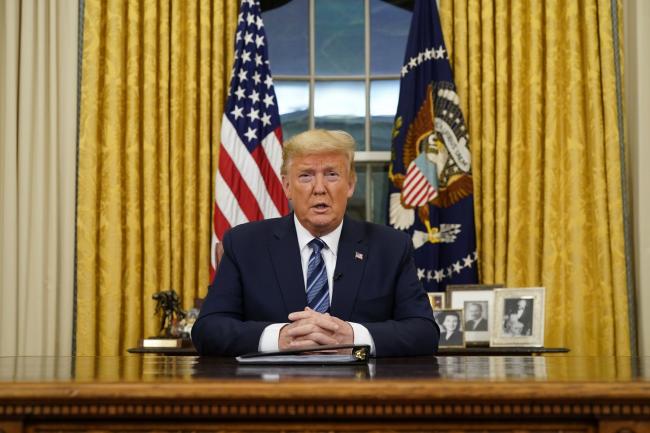(Bloomberg) --
The rout in global stocks deepened as investors showed a lack of faith in the U.S. and European policy responses to the worsening spread of the coronavirus. The dollar surged.
The S&P 500 Index plunged as much 8.5% and the Dow Jones Industrial Average posted its biggest loss since the flash crash in May 2010. European stocks tumbled 12% in a record intraday rout. The selling that started the U.S. day triggered a 15-minute NYSE-mandated halt, and trading will stop again if S&P 500 losses reach 13% any time before 3:25 p.m. in New York.
Ten-year Treasury yields declined, but came off their lows of the day. Oil dropped along with gold. Brazil’s currency fell to a record.
President Donald Trump’s travel ban and tepid fiscal measures failed to impress investors, sparking the latest leg down in risk assets. The European Central Bank failed to stem the rout after it left rates unchanged, though it temporarily increased its bond buying program and took steps to boost liquidity. The World Health Organization earlier called the outbreak a pandemic and other countries, such as the U.K., have taken more extreme measures to try to blunt the threat to growth.
“At this stage people are panicking,” said Chris Rupkey, chief financial economist for MUFG Union Bank. “The other shoe keeps dropping in a way we can’t foresee.”
On another bruising day across markets:
- The S&P 500, Nasdaq Composite and Nasdaq 100 indexes sank deeper into a bear market, with losses from February closing records extending past 20%.
- The MSCI All-Country World Index extended losses to enter bear-market territory.
- The Stoxx Europe 600 tumbled the most on record, with trading volumes more than double the 100-day average. The cost of insuring debt issued by Europe’s investment grade companies surged to the highest since 2016.
- Japanese stocks closed more than 4% lower even after another liquidity pledge from the country’s central bank. Australian shares were among the worst performing worldwide, sinking deeper into a bear market despite a stimulus plan there. India’s benchmark fell more than 8%.
- Oil extended losses toward 5%. Bitcoin slumped. Gold fell below $1,600 an ounce.
“Market moves suggest monetary stimulus has reached its limits,” said Lucas Bouwhuis, a portfolio manager at Achmea Investment. “Most of the stimulus needs to come from the fiscal side and we are just not seeing enough of that yet.”
Meanwhile, signs that companies in the hardest-hit industries were drawing down credit lines to battle the effects of the virus on their businesses added to anxiety.
“The risks have definitely risen,” said Chris Gaffney, president of world markets at TIAA. “The question is how long will this last and I don’t think anybody can predict that at this point.”
These are the main moves in markets:
Stocks
- The S&P 500 Index declined 8.2% as of 11:53 a.m. New York time.
- The Stoxx Europe 600 Index fell 12%.
- The MSCI Asia Pacific Index dipped 5.6%.
- The MSCI Emerging Market Index sank 6.9%.
- The Bloomberg Dollar Spot Index gained 1.7%.
- The euro weakened 1.5% $1.11.
- The Japanese yen fell 1% to 105.54 per dollar.
- The yield on 10-year Treasuries sank 10 basis points to 0.77%.
- Germany’s 10-year yield rose two basis points to -0.73%.
- Britain’s 10-year yield declined two basis points to 0.27%.

- West Texas Intermediate crude declined 5.3% to $31.23 a barrel.
- Gold weakened 4.3% to $1,565.39 an ounce.